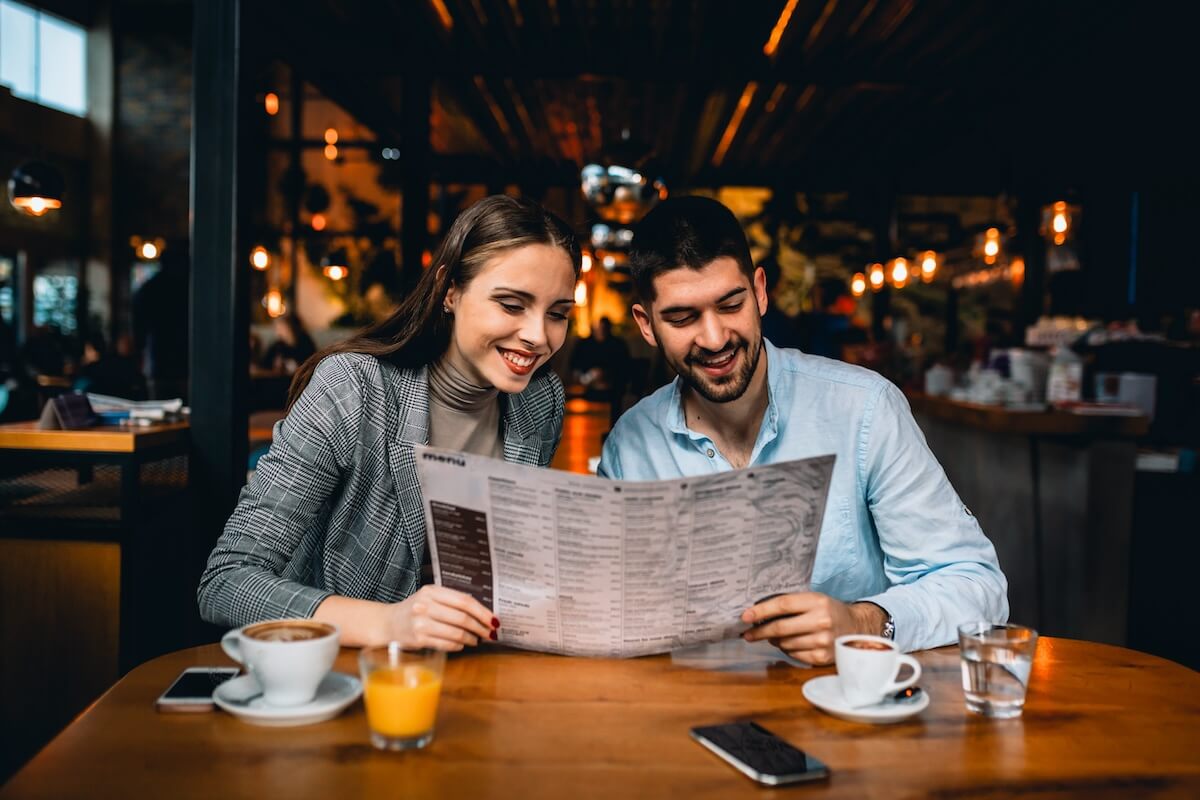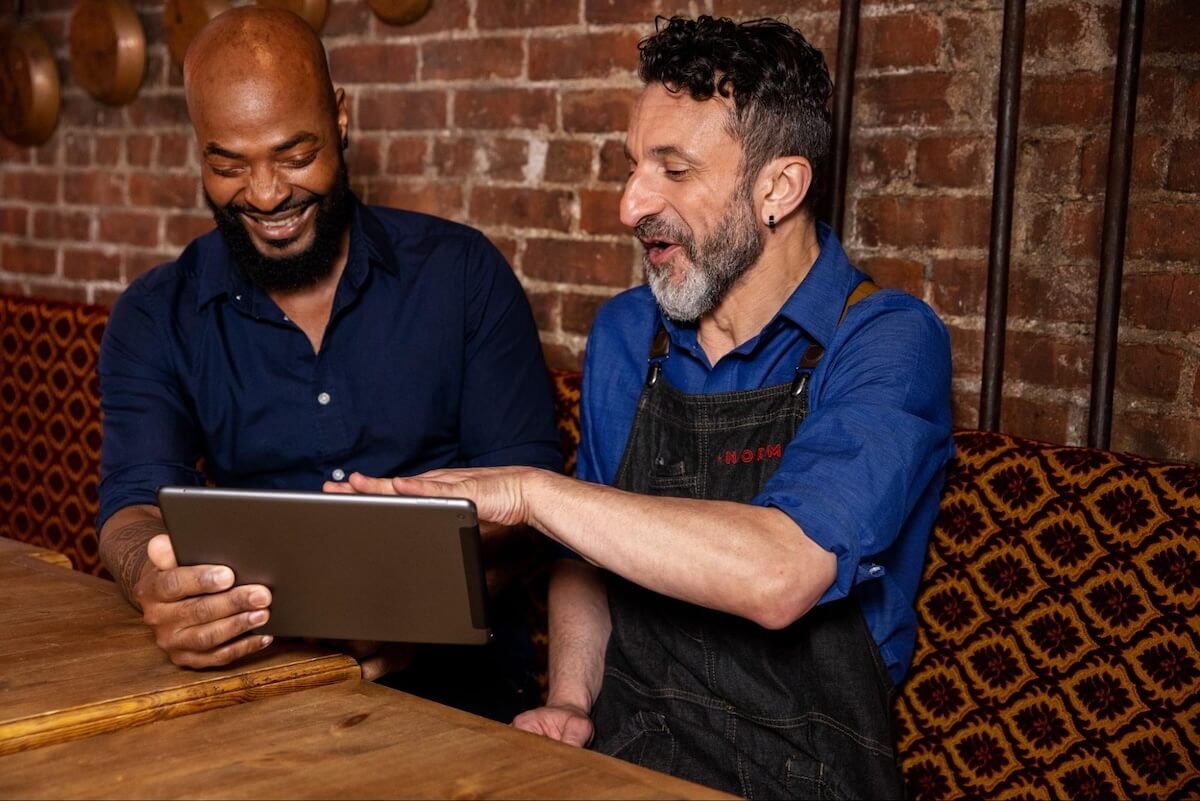10 simple yet effective restaurant menu design tips

A flashy website. Retro signage. A live music stage. None of these features top the food menu as your restaurant’s most important sales tool. Whether your business is a new restaurant trying to make a name for itself, or you’re an old establishment eager for a fresh look, strategic restaurant menu design is crucial to the customer experience.
The menu is the most important tool you can use to catch a customer’s eye and create a quality dining experience. Even to-go customers use online menus as a guide for how they want their meal to unfold. Simply put, your menu is the single most important piece of information your customers have about you.
A well-designed menu can go a long way in illustrating your restaurant’s personality. The brief moment of time customers spend reading your menu items is a pivotal time with which to foster a connection and create long-term, dedicated customers. Plus, the quicker your diners get a grasp of your menu, the quicker they are to order, which can help reduce wait times.
Here are 10 key restaurant menu design tips that can help elevate your food to the next level.
1. Choose a restaurant menu template
There are a wide variety of websites and software programs that allow you to create a restaurant menu design from any number of design templates. Whether you’re creating a simple bar menu, a seasonal cocktail menu, or an entirely new menu for your range of entrees or appetizers, there’s a template out there that will do the job.
When choosing a restaurant menu template, make sure to choose one that’s appropriate for the size and scope of your establishment. For instance, a café menu template intended for use by a coffee shop may not always be the right one to use for a prix fixe menu at a fine dining establishment.
Recall that menus don’t always have to be on paper handed directly to customers. Old-school BBQ restaurants have sign-post menu design and fast food restaurants have menu screens behind the cashiers. The point is this: The template should match the vibe of your restaurant, whether you’re running a food truck, a family-style Italian restaurant, or any other variety of eatery. There’s no need to reinvent the wheel: Follow the standard in your sector and use that to make customers do as little mental work as possible.
2. Use photos and visuals

If you’re a quick service restaurant, incorporating photos of selected items on your food and drink menu can go a long way to whet the appetite of customers and create excitement and anticipation for certain dishes. The caveat to this menu design strategy is that it is highly dependent on how casual your establishment is.
No menu should have too many photos on it. If you’ve ever stood at an ice cream truck and looked at the all different labels of types and flavors, you can understand just how overwhelming too many photos can be. Use key images of dishes you’d like your establishment to be most known for, or that best express the vibe you’re trying to convey.
One caveat here would be if you’re running a restaurant serving food that people in your area may be unfamiliar with. For example, if you’re running an Indian restaurant in an area without many other Indian restaurants, putting photos of dishes may be wise so that customers don’t get confused by unfamiliar dish names like chana masala or palak paneer. In that case, photos are absolutely your friend and should feature prominently on your menu.
3. Incorporate icons
The use of icons to help patrons navigate the menu is an important component of menu engineering. Depending on what kind of cuisine you’re offering, icons can represent different things. Mexican, Indian, or Thai restaurants can utilize specific icons to indicate the spiciness of dishes, for example.
Other icons can be to upsell new items, or to signify if dishes are gluten-free, dairy-free, vegetarian, or vegan. Icons are a great way to answer complex questions diners may have about certain dishes with simple pictures. You can also use icons to indicate customer favorites or best sellers to help guide new customers to some of your most trusted dishes.
4. Use a consistent color scheme
While too many photos can make your menu difficult to read, so too can elaborate color schemes. A key element of your menu’s graphic design is to make sure that the colors are uniform throughout. Utilizing too many colors can go from eye-catching to distracting, while mixing up colors that have different subliminal meanings may confuse readers all together.
Marketing and advertising firms have spent decades studying how colors influence the behavior and decisions of diners. For example, brown represents simplicity and wholesomeness, while green represents freshness.
Ideally, your color scheme should be a no-brainer once you’ve worked out your restaurant branding. Stick with a solid color scheme throughout the restaurant and the menu colors will resolve themselves.
5. Use fonts consistently

Similarly, be sure to stick to one or two fonts throughout your menu design. Using different fonts for different sections of your menu can be confusing to readers. The use of a single font can go a long way in giving your restaurant a defined, recognizable personality.
An italic font could convey a sense of sophistication, while crisper, blockier fonts can exude confidence and a sense of contemporary style. Experiment with a few varieties of typography to make sure you hone in on the one that truly expresses what you want your food and dining experience to be about.
As with your menu’s color scheme, your font should be standard throughout your restaurant due to your branding operations. Stick to your guns and you’ll be just fine.
6. Avoid currency symbols
According to Cornell University, restaurant owners are encouraged to avoid the use of currency symbols like dollar signs when coming up with their restaurant menu design. Placing whole-dollar prices at the end of each item (like $10 instead of $10.50) can help reduce decision and cost anxiety. In addition, menu prices that end in a number other than zero (like $11 or $24) are often interpreted as more friendly and inviting. You can work around food costs by simply rounding up to the nearest dollar value when running your numbers.
7. Make appropriate use of “The Golden Triangle”

So what does a good menu look like? People’s eyes follow a natural path, whether they’re reading a menu or a magazine. So, how your food items are arranged on your menu matters. According to research by restaurant consulting firm Aaron Allen and Associates, people’s eyes begin in the middle of a menu, before moving to the top right corner, and finally to the top left corner. This concept is what restaurant menu engineers have dubbed the “Golden Triangle,” a key component of a menu layout.
Menu engineers frequently place the most expensive cuisine options in these locations so that diners feel compelled to peruse the rest of the menu. We’ve covered menu engineering in great depth, and highly recommend checking it out.
8. Choose language carefully
The most successful, best-received menus tend to have detailed menu descriptions of foods that utilize language that makes diners feel less guilty about ordering less-than-healthy or high calorie options. For example, fried foods often become “crispy,” foods high in fat become “rich” or “creamy” and butter and other toppings are described as “glazes.” Make sure to use customer-friendly language when writing your menu, even if it means getting diners to cheat a little so they order your specialty entrees.
Your copy should go through multiple edits as it’s one of the most important ways to convey your restaurant’s identity and the food you serve to customers. Keep it succinct while conveying exactly what customers can expect from a dish. Be sure to note flavors, preparation methods, ingredients, and potentially the origin of the dish. Then do your darndest to make someone hungry with the words you’re using. If writing isn’t exactly your forté, you can always hire a freelancer to make your food sound mouthwatering.
9. Don’t overwhelm
It is believed that no more than seven choices should be given for each menu section. This is largely understood to be the largest number of choices diners can have presented to them before a sense of anxiety and a lower sense of quality-to-value sets in. So while it can be tempting to place absolutely everything you and your staff are capable of making on your menu, keeping it simple will win the day.
A good way to prevent overwhelming a customer, in addition to limiting menu items, is to make sure items are categorized well. Be sure your soups, appetizers, entrées, desserts, drinks, and so on are all adequately labeled with a large enough heading that customers’ eyes instantly jump to the point they want to see.
10. Launch a digital menu
The pandemic era kick-started digital menus, which at the time all but completely replaced paper menus in dining establishments across the globe. That trend is here to stay, though paper menus are likely never going to be obsolete.
QR codes that open up digital menus in both iOS and Android are now the norm across the food service industry, from fine dining establishments to simple lunch spots.
This development offers a wide variety of advantages that restaurateurs never had before. It cuts back on the expense of annual menu printing, which can be costly. Plus, the integration of a digital menu allows your restaurant menu design to remain permanently dynamic. Menu items, happy hour times, specials, even nutritional information can change from day to day, as can drink and dessert specials. Design tools like Canva can make digital menu design easy, with customizable design elements, high-quality free templates, easy graphic design tools, and more. If you can master Adobe Illustrator, well, then you’re already a whiz.
While a sense of consistency is always important in any restaurant menu design, the ability to alter or even make subtle changes to dishes and special event cuisine on digital menus gives incredible freedom to menu designers and chefs alike.
Fast food restaurants are even using digital menu board templates and digital signs to alter their menus depending on the time of day they’re serving.
Having both a digital menu and a physical menu is your best bet for the moment, since plenty of customers in many demographics still like having the physical object in their hands. Your digital menu can help bring your website to life and give you a leg up in third-party delivery services if you’re looking to expand that direction.
Give your menu life

By incorporating some or all of these techniques, your restaurant menu design can become the ultimate business card for your restaurant. By encouraging diners to do things like share their experience through social media feeds, a properly designed menu can become an integral part of your restaurant’s brand. Be sure to claim your spot on Google and promote your menu, link it to your Yelp account, have your menu prominently featured on Instagram, and so on.
Restaurants are always looking for other new and dynamic ways to engage diners. Menus are a critical component of running a restaurant, but so is online presence and front-of-house operations. If you’re looking for software that does everything customer-facing—and does it well—you’ll want to check out Yelp Guest Manager.
Whether you’re trying to attract takeout, delivery, or dine-in customers to your restaurant, Yelp Guest Manager can help. Paired with your Yelp Business page, it’s the ideal tool to getting discovered by hungry diners.
Reach out to us for a free demo and we’ll take you for a test drive. Revamping your menu is an excellent way to level up, and so is software. Once you’ve got it, you may wonder how you lived without it before.